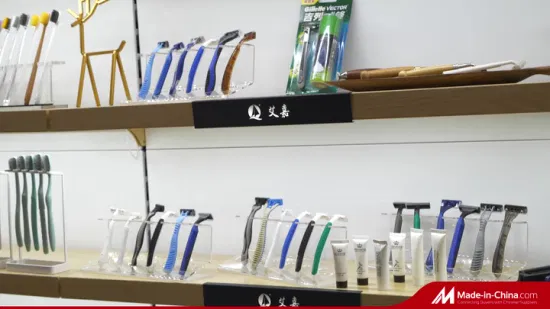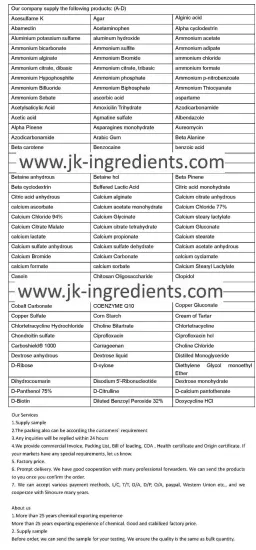
Vitamin B2 Riboflavin 80% 98% CAS No. 83
What is Riboflavin ? Riboflavin, regulates red blood cell growth and helps maintain a strong immune system by protecting
Description
Basic Info.
| Model NO. | vitamin |
| Nutrient Composition | Vitamin |
| Resource | Chemosynthesis |
| The content of active substances | 61%~90% |
| Loading Port | Qingdao |
| Delivery | 15days |
| Loading Port 2 | Shanghai |
| M G | 376.36 |
| Store | Dry and Cool Place |
| Transport Package | 25kg/Drum |
| Specification | Food grade |
| Trademark | JK |
| Origin | China |
| HS Code | 293623 |
| Production Capacity | 100mt/Year |
Product Description
What is Riboflavin ?
Riboflavin, regulates red blood cell growth and helps maintain a strong immune system by protecting the body from free-radical damage. Riboflavin also promotes healthy hair, skin, nails, and vision.Without riboflavin, the other B vitamins, especially niacin (vitamin B3) and pyridoxine (vitamin B6), cannot do their job, and a host of chemical processes necessary to keep the body alive would come to a grinding halt.
You also need riboflavin to produce flavin mononucleotide and flavin adenine dinucleotide, two enzymes that help the body convert fats, carbohydrates, and proteins into energy. Without enough riboflavin, these two enzymes are unable to work together to ensure your cells can both reproduce correctly and supply the body with the fuel it needs stay alive.
Function of Riboflavin
1. Help to improve the quality of life2. Treatment of Migraine
3. Promote the development and cell regeneration
4. To the skin, nails, hair, the normal growth
5. To help eliminate the mouth, lips, tongue inflammation
6. to enhance visual acuity, reducing eye fatigue
Application of Riboflavin
Riboflavin (vitamin B2) is the essential necessity for organism in normal living as the nutriment for infant, pregnant woman, nursing mother, patient after illness and the aged. It, involve, participates in the metabolism of carbonhydrate, protein and fat, and is the major composition of flavor protein, the transferring enzyme system of hydrogen. In clinical practice, it is applicable to perleche, glossitis, ophthalmitis, conjunctivitis, seborrhea, scrotum inflammations with proper effect, in food and feed industry, it is widely used as food and feed additive and have the Kosher Certified.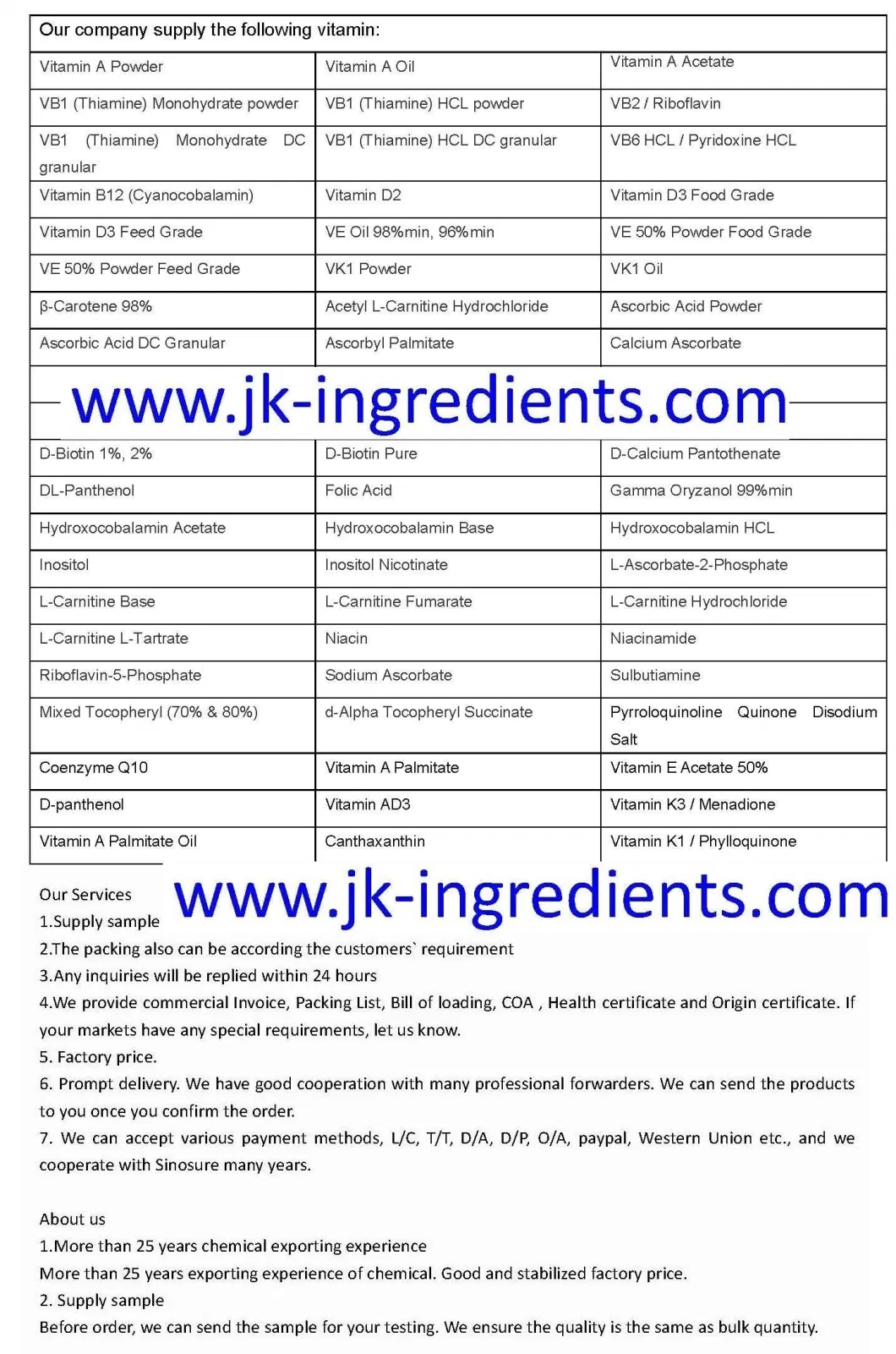
| Riboflavin Basic information |
| Product Name: | Riboflavin | ||
| Synonyms: | vitasanb2;xypentyl)-;E 101;Riboflavin (1.07609);Riboflavin Vitamin B2;Vitamin B2 (Riboflavine);RIBOFLAVIN DC GRADE;Riboflavin Bp | ||
| CAS: | 83-88-5 | ||
| MF: | C17H20N4O6 | ||
| MW: | 376.36 | ||
| EINECS: | 201-507-1 | ||
| Product Categories: | PHARMACEUTICALS;Chiral Reagents;Heterocycles;Intermediates & Fine Chemicals;Vitamin series;API;Miscellaneous Natural Products;Biochemistry;Vitamins;Nutritional Supplements;FLAVAXIN;Isolabel;vitamin;Inhibitor of poly(ethylene glycol) oxidation.;Vitamins and derivatives;Vitamin Ingredients;Miscellaneous Compounds;Inhibitors | ||
| Mol File: | 83-88-5.mol | ||
| Riboflavin Chemical Properties | |||
| Melting point | 290 °C (dec.)(lit.) |
| alpha | -135 º (c=5, 0.05 M NaOH) |
| Boiling point | 504.93°C (rough estimate) |
| density | 1.2112 (rough estimate) |
| refractive index | -135 ° (C=0.5, JP Method) |
| Fp | 9ºC |
| storage temp. | 2-8°C |
| solubility | Very slightly soluble in water, practically insoluble in ethanol (96 per cent). Solutions deteriorate on exposure to light, especially in the presence of alkali. It shows polymorphism (5.9). |
| pka | 1.7(at 25ºC) |
| form | Powder |
| color | Yellow to orange |
| Odor | Slight odour |
| PH | 5.5-7.2 (0.07g/l, H2O, 20°C) |
| PH Range | 6 |
| Water Solubility | 0.07 g/L (20 ºC) |
| Sensitive | Light Sensitive |
| Merck | 14,8200 |
| BRN | 97825 |
| Stability: | Stable, but light-sensitive. Incompatible with strong oxidizing agents, reducing agents, bases, calcium, metallic salts. May be moisture sensitive. |
| InChIKey | AUNGANRZJHBGPY-SCRDCRAPSA-N |
| CAS DataBase Reference | 83-88-5(CAS DataBase Reference) |
| NIST Chemistry Reference | Riboflavine(83-88-5) |
| EPA Substance Registry System | Riboflavin (83-88-5) |
| Safety Information |
| Hazard Codes | F,T | ||
| Risk Statements | 11-23/24/25-39/23/24/25 | ||
| Safety Statements | 24/25-45-36/37-16 | ||
| RIDADR | UN1230 - class 3 - PG 2 - Methanol, solution | ||
| WGK Germany | 1 | ||
| RTECS | VJ1400000 | ||
| F | 8-10-21 | ||
| TSCA | Yes | ||
| HS Code | 29362300 | ||
| Hazardous Substances Data | 83-88-5(Hazardous Substances Data) | ||
| Toxicity | LD50 in rats (g/kg): >10 orally, 5.0 s.c., 0.56 i.p. (Unna, Greslin) | ||
| MSDS Information | |||
| Provider | Language | ||
| Riboflavin | English | ||
| ACROS | English | ||
| SigmaAldrich | English | ||
| ALFA | English | ||
| Riboflavin Usage And Synthesis | |||
| Chemical Properties | Yellow to orange/yellow crystalline powd |
| Uses | Nutritional factor found in milk, eggs, malted barley, liver, kidney, heart, leafy vegetables. Richest natural source is yeast. Minute amounts present in all plant and animal cells. Vitamin (enzyme cofactor). |
| Uses | Vitamin B2; Vitamin cofactor; LD50(rat) 560 mg/kg ip |
| Uses | riboflavin (Vitamin B2) is used in skin care preparations as an emollient. It can be found in sun care products as a suntan enhancer. Medicinally, it is used for the treatment of skin lesions. |
| Uses | Riboflavin is the water-soluble vitamin b2 required for healthy skin and the building and maintaining of body tissues. it is a yellow to orange-yellow crystalline powder. it acts as a coenzyme and carrier of hydrogen. it is stable to heat but may dissolve and be lost in cooking water. it is relatively stable to storage. sources include leafy vegetables, cheese, eggs, and milk. |
| Uses | Vitamin B2 (riboflavin) is produced by yeast from glucose, urea, and mineral salts in an aerobic fermentation. |
| Definition | ChEBI: D-Ribitol in which the hydroxy group at position 5 is substituted by a 7,8-dimethyl-2,4-dioxo-3,4-dihydrobenzo[g]pteridin-10(2H)-yl moiety. It is a nutritional factor found in milk, eggs, malted barley, liver, kidney, heart, and leafy vege ables, but the richest natural source is yeast. The free form occurs only in the retina of the eye, in whey, and in urine; its principal forms in tissues and cells are as flavin mononucleotide and flavin-adenine dinucleotide. |
| Brand name | Flavaxin (Sterling Winthrop). |
| General Description | The conflicting results were eventually found to be due,in part, to deficiencies in study animals not just of vitamin B2,but also vitamin B3 (niacin), the cause of human forms of pellagra,and/or vitamin B6 (pyridoxine), another cause of dermatitis.Likewise, treatments with vitamin B2 were inconsistentbecause the early sources of this vitamin contained otherB vitamins. Vitamin B2 was eventually isolated from eggwhites in 1933 and produced synthetically in 1935. Thename riboflavine was officially accepted in 1960; althoughthe term was in common use before then. In 1966, IUPACchanged it to riboflavin, which is in common use today.Riboflavin is synthesized by all green plants and by mostbacteria and fungi. Therefore, riboflavin is found, at least insmall amounts, in most foods. Foods that are naturally highin riboflavin include milk and other dairy products, meat,eggs, fatty fish, and dark green vegetables. Chemically, riboflavin is an N-glycoside of flavin, alsoknown as lumichrome, and the sugar, ribitol .Flavin is derived from the Latin word flavus for "yellow"because of the yellow color of its crystals and yellow fluorescenceunder UV light. Riboflavin is heat stable but easilydegraded by light. Its systematic names are 7,8-dimethyl-10-ribitylisoalloxazine and 7,8-dimethyl-10-(D-ribo-2,3,4,5-tetrahydroxypentyl)isoalloxazine. |
| Clinical Use | Severe riboflavin deficiency is known as ariboflavinosis, andtreatment or prevention of this condition is the only provenuse of riboflavin. Ariboflavinosis is most commonly associatedwith multiple vitamin deficiency as a result of alcoholismin developed countries. Because of the large numberof enzymes requiring riboflavin as a coenzyme, deficienciescan lead to a wide range of abnormalities. In adults seborrheicdermatitis, photophobia, peripheral neuropathy, anemia, andoropharyngeal changes including angular stomatitis, glossitis,and cheilosis, are often the first signs of riboflavin deficiency.In children, cessation of growth can also occur. As the deficiencyprogresses, more severe pathologies develop untildeath ensues. Riboflavin deficiency may also produce teratogeniceffects and alter iron handling leading to anemia. |
| Safety Profile | Poison by intravenous route. Moderately toxic by intraperitoneal and subcutaneous routes. Mutation data reported. When heated to decomposition it emits toxic fumes of NOx. |
| Purification Methods | It crystallises from H2O as a yellow-orange powder in three different forms with differing amounts of H2O. It melts if placed in an oil bath at 250o, but decomposes at 280o if heated at a rate of 5o/minute. It is also purified by crystallisation from 2M acetic acid, then extracted with CHCl3 to remove lumichrome impurity. [Smith & Metzler J Am Chem Soc 85 3285 1963.] Its solubility in H2O is 1g in 3-15L depending on the crystal structure. Its solubility in EtOH at 25o is 4.5mg in 100mL. Store it in the dark because it is decomposed to lumichrome by UV light. [Pearson The Vitamins vol V pp1-96 1967 and vol VII pp 1-96 1972, Gy.gy and Pearson eds, Academic Press, Beilstein 26 IV 2542.] |
Hunan JK International Trade Corporation / JK BIO-CHEM CO.,LTD is a professional exporter of food/feed additives and food /feed ingredients in China. With years of development, now we are able to provide the following food additives and food ingredients: thickeners, antioxidants, preservatives, vitamins, sweeteners, proteins, acidulants, nutritional supplements, flavours, coenzyme and so on.
Our food additives and food ingredients, especially our Ascorbic Acid (Vitamin C), Acesulfame-K, Aspartame, Citrates, Dextrose, D-Xylose, Erythorbic Acid, Fumaric Acid, Fructose,Maltodextrin, Malic Acid, Monosodium glutamate, Lactic Acid Potassium Sorbate, Sodium Erythorbate, Sodium Cyclamate, Sodium Saccharin, sodium benzoate, Sodium ascorbate, Sorbic Acid, xanthan Gum, Xylitol, Tartaric Acid, I+G, , Vanillin, Sucralose, Stevia and so on, have been exported to more than 60 countries for our good quality products.
Our staff of sales and technical support is available to help you in selecting the right protection for your application as well as to provide you with samples of our products for evaluation. At High Five, we are committed to providing the highest level of customer service, competitive pricing, speedy delivery and a comprehensive, cutting-edge product offering. Our ultimate goal is your satisfaction.
Packing&Shipping
FAQ
Q1.What's the payment terms?We could accept T/T, L/C, DP payment terms.Q2.How about the different index of products in same application?Specifications can be customized according to your application.Q3.How about the samples of products?We can provide free samples under 2Kg(not including freight charge).Q4.How about the price of products?Our products are chemical synthesis got from underground brine, which is available for a variety of usage. Our products are high purity with good quality, and the price is based on different specification and quantity.Q5.What's the shelf life for the cargoes?Our product's shelf life is 2 years, which is based on dry and ventilated storage.Q6.What's the package of the cargoes?20kg/25kg woven bags, within plastic bags, or as customized.Q7.What's the delivery time?We usually deliver the cargoes within 10~20 days after receiving customer's payment or original L/C.Q8.Which documents can we supply?Commercial Invoice, Packing List, Certificate of Analysis, Certificate of Origin (FORM E), Bill of Loading, ISO etc.The documents will be sent by Express within 24 hours against your full payment.Q9.Why do you choose us?We accept safe and diversified payment terms.We supply a price trend to ensure clients know marketing information in time. We will take charge of 100% responsibility forquality issue. We strive to create value for each customer we serve by meeting their unique needs and providing solutions to solve their problems and achieve their objectives.
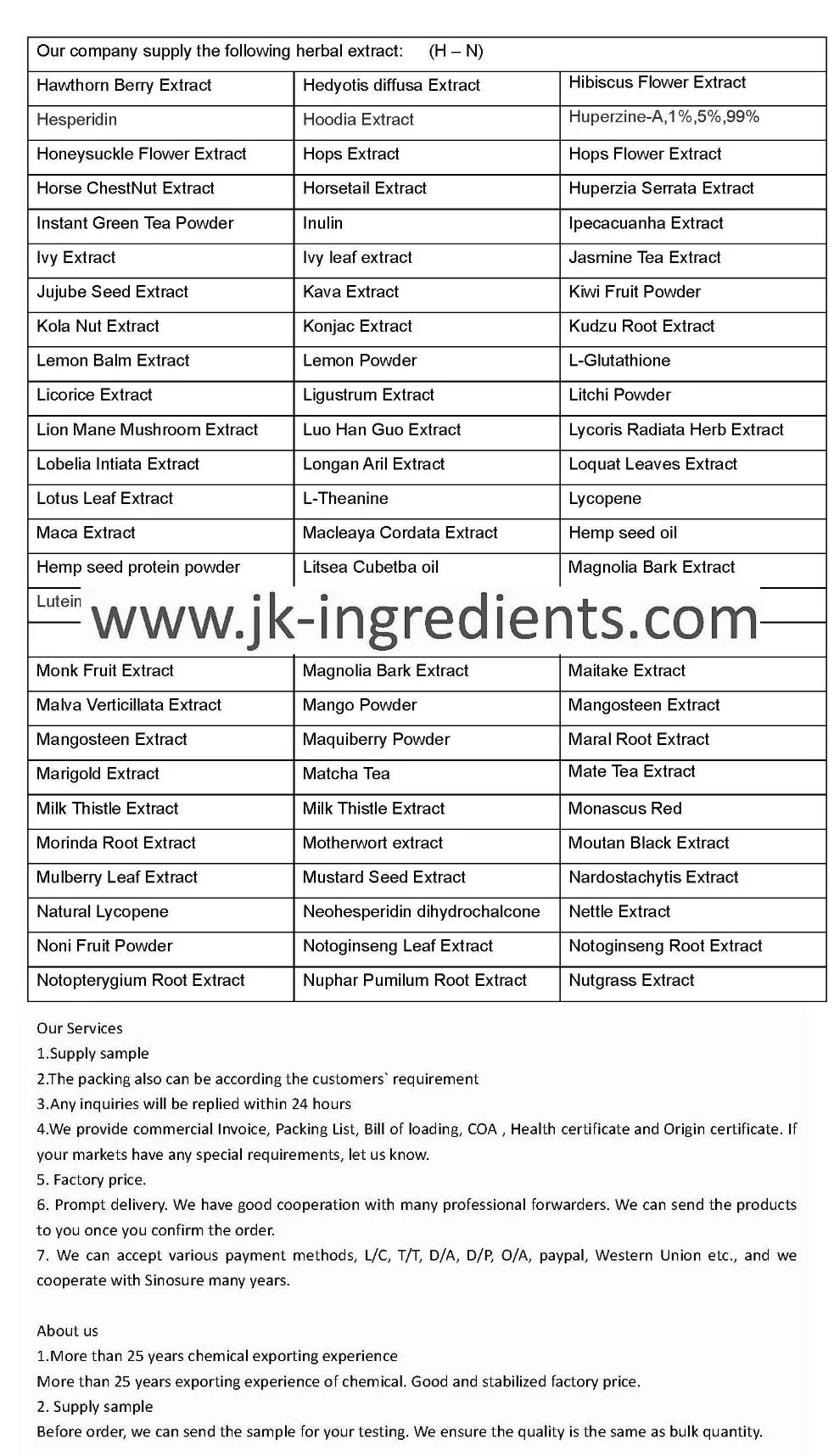
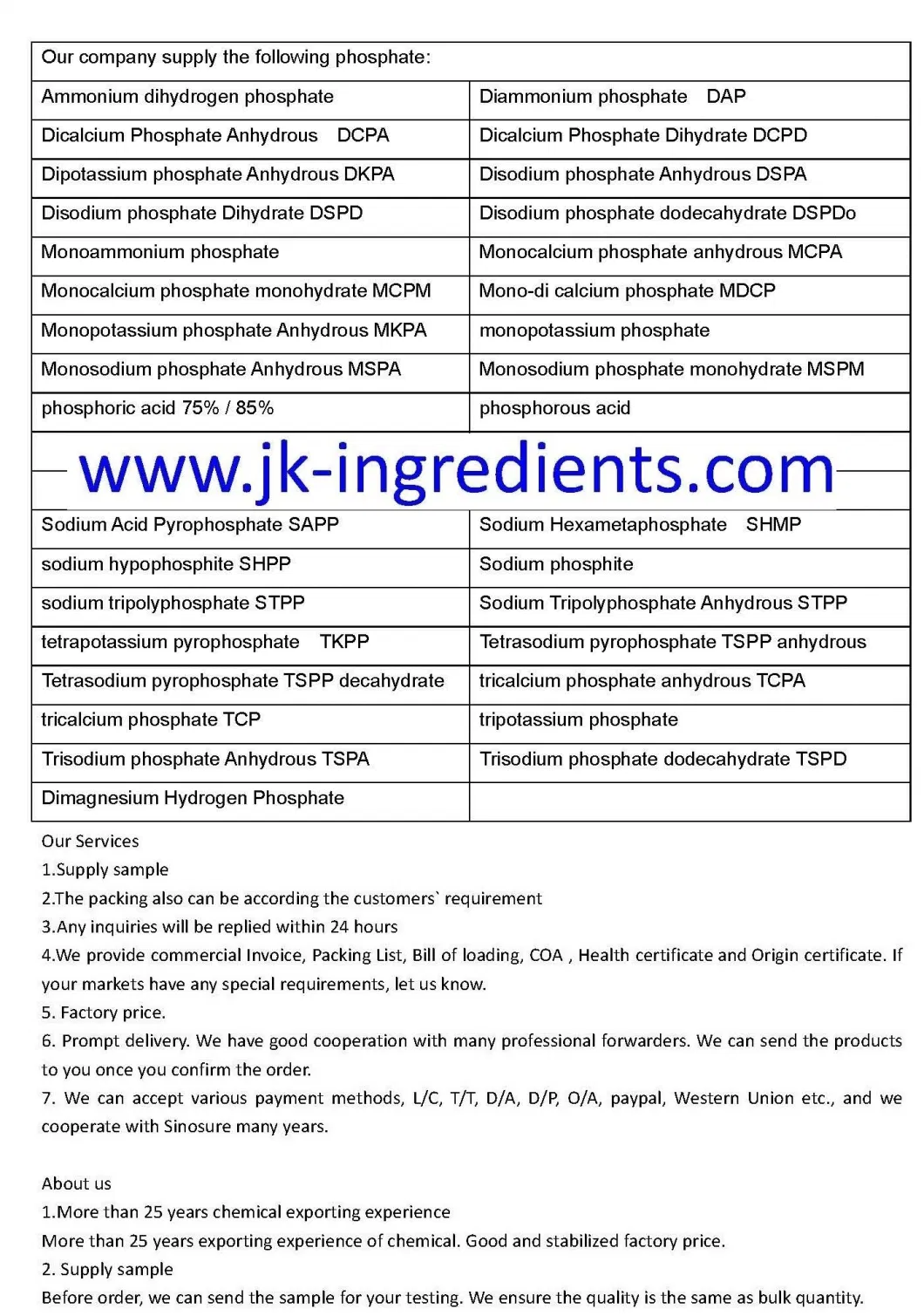
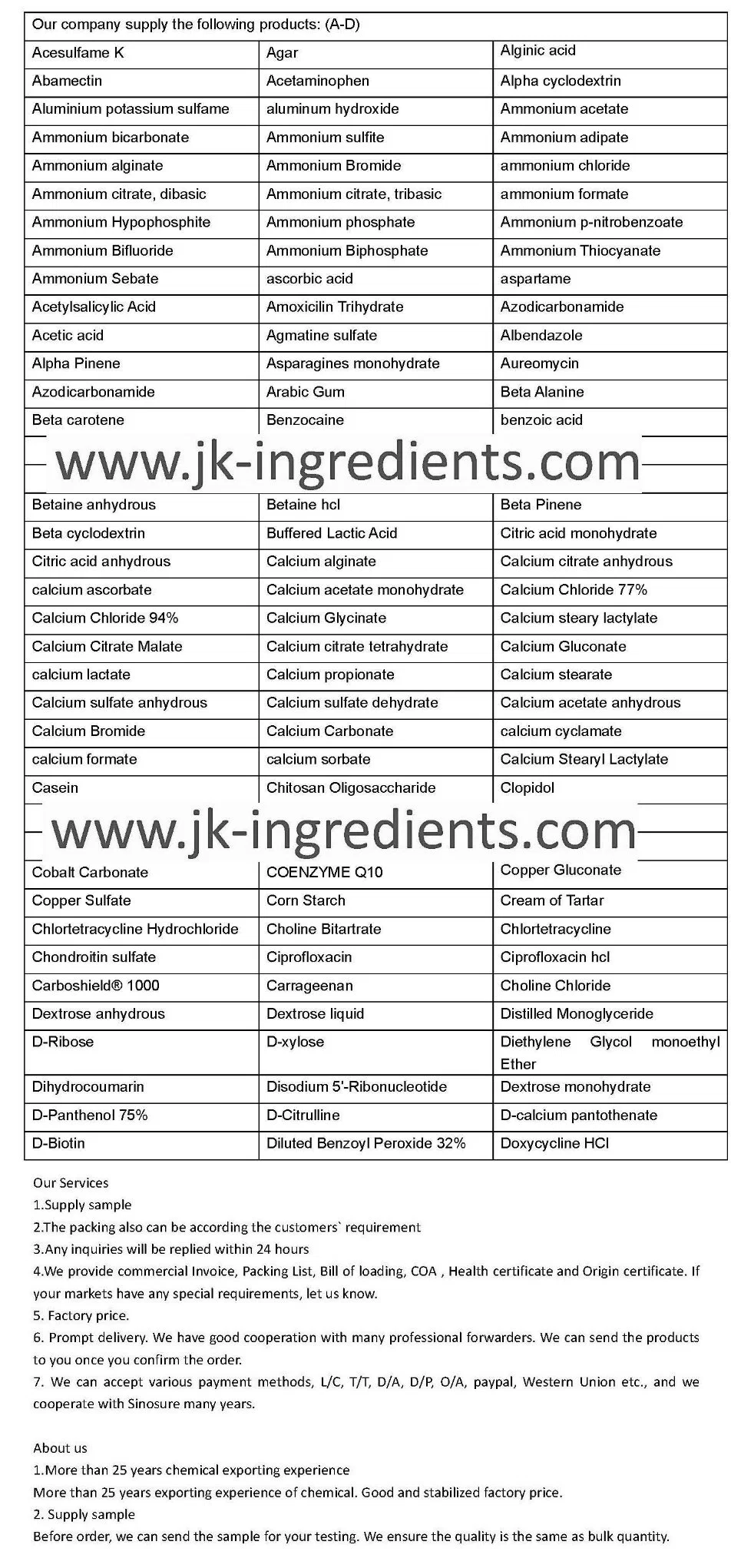
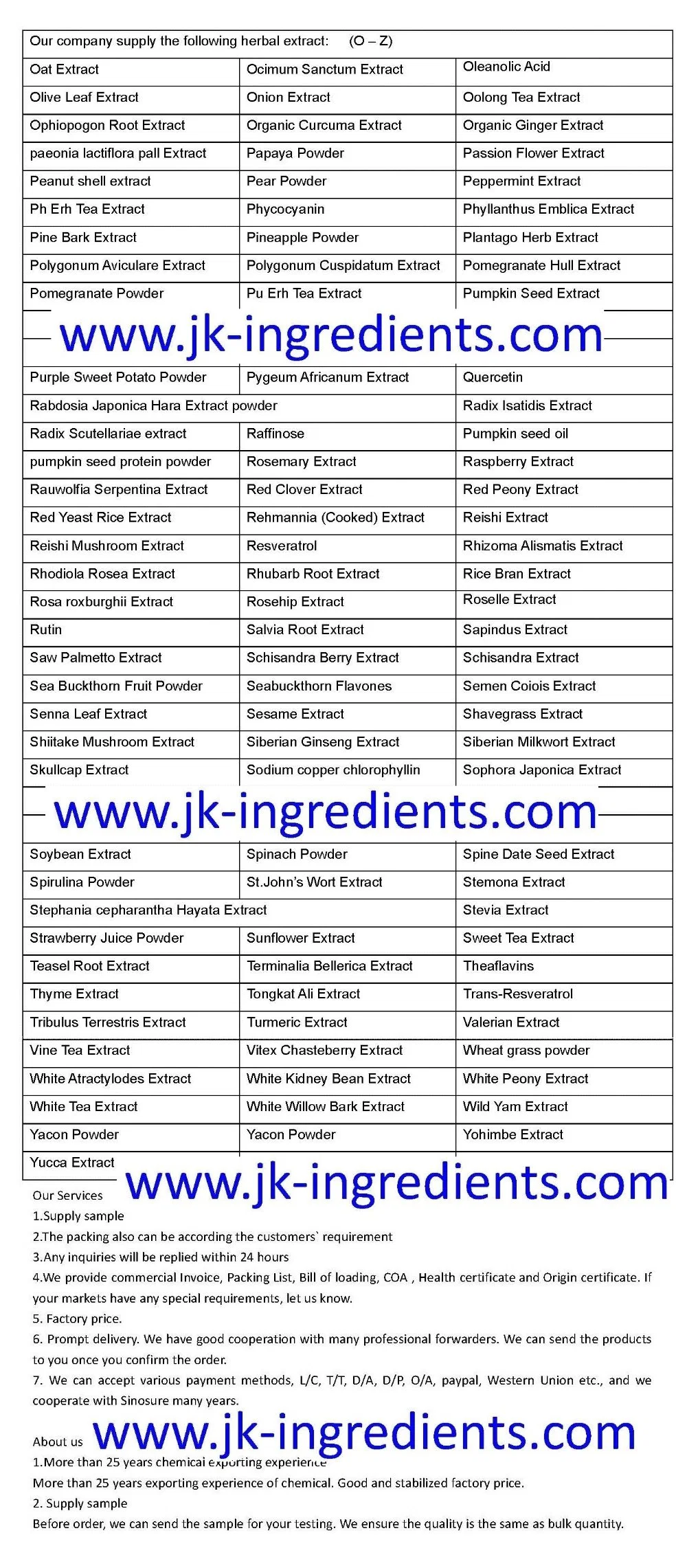
Our Contact
Send now




